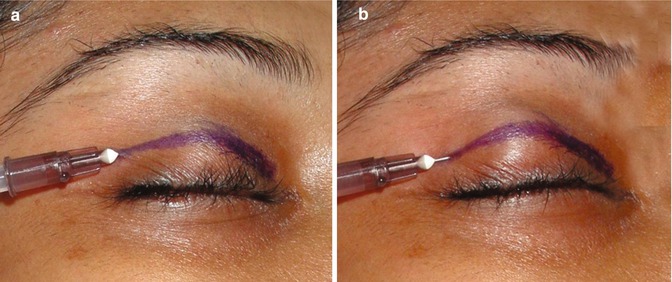(1)
Alo Eye Care, Kolkata, India
Keywords
AnesthesiaRegional sensory blocksInfiltration anesthesiaLacrimal nerveSupraorbital nerveInfratrochlear nerveZygomaticotemporalZygomaticofacialInfraorbital nerve8.1 Introduction
An important decision to be made during the planning of tumor excision and eyelid reconstruction is what anesthesia would be suitable. The challenge lies in having a peaceful, painless, comfortable operation. The mode of anesthesia selected depends on multiple factors, including the patient’s age, the size of the tumor to be excised, the amount of tissue mobilization, and the estimated surgical time.
8.1.1 General Anesthesia
General anesthesia usually is necessary in children. It also should be the mode of anesthesia in cases involving large rotational flaps, such as the Mustarde cheek rotation flap. However, because most lid tumors occur in the older population, there may be hazards in using a general anesthetic approach. Therefore, most small or medium-sized lid tumors may have to be excised under local anesthesia. Even if a lid tumor excision has been planned under general anesthesia, a small infiltration of 2 % lidocaine with adrenaline (epinephrine) 1:200,000 solution to the surrounding area helps in two ways. First, it reduces perioperative oozing through its vasoconstrictive effect, and second, it reduces postsurgical pain following general anesthesia.
8.1.2 Local Anesthesia
Local anesthesia is adequate for most adults and is preferred for most types of biopsies, as well as for excision of small to medium-sized lid tumors. Adequate anesthesia may be obtained with a simple subcutaneous injection of 1.5–2 mL 2 % lidocaine hydrochloride with adrenaline (epinephrine) 1:200,000 solution across the breadth of the lid. A lidocaine-bupivacaine mixture provides adequate anesthesia for a slightly longer duration. Approximately 0.5–1.5 mL of lidocaine hydrochloride is injected subcutaneously across the lid at the level of the lid crease.
8.1.3 Regional Sensory Blocks
Supratrochlear, supraorbital, lacrimal, infratrochlear, zygomaticotemporal, zygomaticofacial, and infraorbital nerve blocks provide relatively good localized sensory anesthesia without causing much localized tissue edema at or around the site of dissection, especially during lid reconstruction.
8.2 Infiltration Anesthesia
Infiltrative anesthesia is used as a local anesthetic technique. The anesthetic agent is infiltrated directly into the surgical site via intradermal, subcutaneous, or subconjunctival injection. Lidocaine hydrochloride, in a 2 % concentration, most commonly is used for this type of infiltration. However, when a long procedure time is expected, an anesthetic with a longer duration of action may be combined with bupivacaine.
The orbicularis muscle is innervated primarily by the zygomatic branch of the facial nerve laterally and by the buccal branch of the facial nerve medially. These branches join to form a plexus of nerves that penetrate the deep surface of the muscle in a segmental fashion. Therefore, infiltrative anesthesia in the periocular region is applied in the suborbicularis plain.
Direct subconjunctival infiltration is applied at the incision site. This approach is useful, especially if the tumor involves only the tarsal aspect and the patient still reports pain despite regional anesthesia.


Fig. 8.1




(a) Technique of subcutaneous infiltrative anesthesia. (b) Subcutaneous swelling following infiltrative anesthesia
Stay updated, free articles. Join our Telegram channel

Full access? Get Clinical Tree


